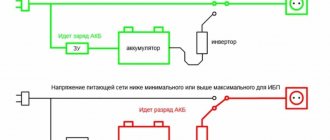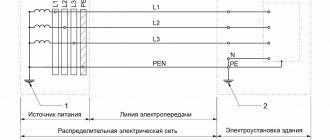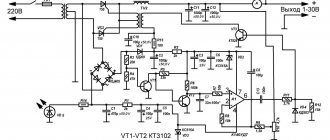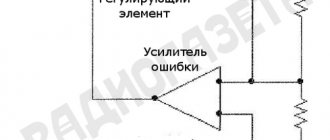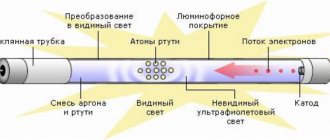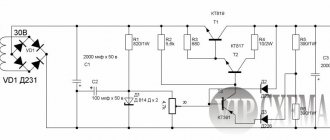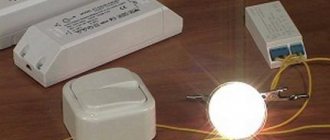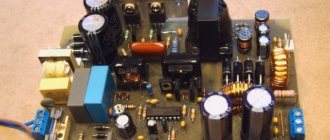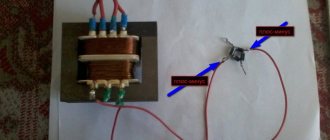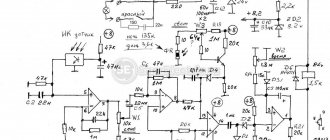It is recommended to use an uninterruptible power supply (UPS) for a computer when there are frequent power surges or when important information needs to be saved. There are different types of such devices. When choosing, the main parameters are taken into account and correlated with the characteristics of the PC. This ensures reliable operation of the computer.
What is an uninterruptible power supply
A UPS is a device that allows a computer to operate for a short period of time when there is no voltage in the electrical network. It contains a battery that turns on when power from the electrical network stops flowing. In this case, the uninterruptible power supply signals a loss of current. And the user can save the data and complete the work before the battery runs out. When power surges occur, the UPS intercepts them so that the computer hardware is not damaged.
The difference between a UPS and an auxiliary generator or standby generator system is that it provides instant protection against power outages thanks to the energy stored in the batteries. In this case, the computer does not interrupt its operation. Transitioning to an auxiliary power system takes time.
Uninterruptible power supplies are used to protect hardware such as computers, data centers, telecommunications or other electrical equipment where an unexpected power outage could result in injury, death, serious operational disruption or loss of data.
Recovery
How to restore uninterruptible power? Without special skills, you can restore an uninterruptible power supply yourself only when the problem lies in the battery. Replacing it is extremely simple. In remaining cases, repairs can only be made by a specialist. How can you understand that the UPS has burned out and why did this happen? You can tell that something irreparable has happened by the characteristic burning smell. This may be caused by a large power surge in the network. In this case, the fuse included in the UPS design should burn out. Also, the reason that the uninterruptible power supply has burned out may be a short circuit. In such cases, the possibility of recovery depends on the nature of the damage and its volume. There are a number of cases when repairing uninterruptible power supplies becomes impossible. This primarily concerns mechanical damage. If the UPS has fallen from a great height and is seriously damaged, then you can safely start looking for a replacement. Fires can cause irreparable heat and fire damage. Floods or other situations when water gets inside the UPS can also put an end to the life of uninterruptible power supplies. If used for a very long time, the electrolyte in the capacitors may dry out. If your UPS is old, then it will probably be impossible to find spare parts for such a model. In this case, it is better to think about purchasing a more modern and reliable model. Don’t forget about the cost of repairs, which in some situations may exceed the cost of the UPS itself. In all of the above cases, it is pointless to look for the reason that the UPS turns off every time it starts.
Main characteristics
An important characteristic of a UPS is its output power. The total power of devices that can be connected to this source depends on it. To determine it you need:
- check the power of each device that will operate through the UPS and add everything up;
- we convert the value obtained in the previous step from watts to VA, to do this we divide it by the power factor (cosϕ) equal to 0.6;
- to ensure a reserve, we increase the resulting value by 20%, that is, we multiply everything by 1.2.
Let's give an example of a calculation. Let's say we have a 250 W computer, a 30 W monitor and 5 W speakers.
We determine their total power:
Pw = 250 + 30 + 5 = 285 W.
Now you can find out the minimum permissible power of the UPS:
Pva = (Pw/0.6) * 1.2 = (285/0.6)*1.2 = 570 VA
When determining the power consumed by a personal computer, it is incorrect to focus on the power of its power supply. You can determine the real value using a household ammeter or wattmeter with a socket. If there is no such device, then you can calculate the required value using an apartment meter. To do this you need:
- disconnect all devices that consume electricity from the network;
- turn on the PC and run a frequently used program on it;
- when the meter readings increase by one tenth of a kilowatt, start counting down the time until the next change in readings;
- calculate the power consumed by the computer using the formula: P = 100 * (60 / t), where t is the time the meter reading changes by 0.1 kW.
The next most important parameter will be the time during which the UPS can ensure the functioning of the devices connected to it during a power outage. Manufacturers often indicate a value that is measured when the maximum load is connected. But usually the uninterruptible power supply operates at powers less than the maximum, and its battery life will be longer than stated by the manufacturer. The increase in operating time is not proportional to the decrease in load. When the total load power is halved, the battery life can increase by 2.5–5 times, and when the load drops three times, by 4–9 times.
When choosing an uninterruptible power supply, you should also pay attention to the characteristics:
- device output voltage;
- Transfer time is the time it takes for the UPS to switch from utility power to battery power.
Before buying a UPS, you need to determine what equipment you will connect to it - this determines how many and what connectors will be at the output of the power source. The following interfaces are often encountered:
- CEE 7 Schuko, or Euro socket, is needed to connect a Wi-Fi router or other equipment;
- IEC 320 C13, or computer connectors.
The display itself can also be useful. It can display important information: voltage at the input and output of the device, battery charge level, output power.
Uninterruptible power supplies built on the double conversion principle, as well as some linear-interactive models, generate a lot of heat during operation and need to be removed. Most often, a fan is used for this purpose, which makes noise. This point is also worth paying attention to.
The cold start feature can also be useful. Then the device can be turned on even if there is no electricity in the network.
These are all the main characteristics of a UPS.
Popular models
When deciding how to choose an uninterruptible power supply for your computer , do not forget about the device manufacturers. Popular brands that offer high-quality and efficient UPSs include Powercom , P-com and APC . Products from other manufacturers are also popular, whose pricing policy makes the purchase more affordable - but the quality of such sources is usually lower.
APC Black-UPS 500
Compact model that supports connecting equipment with a power of up to 300 W. Allows you to connect up to 3 devices to the internal battery and one directly.
It has recharging function - this action will take at least 6 hours.
time at full load is up to 5 minutes, an office PC (200-250 W of power) can work up to 10 minutes.
The advantages of the model are considered to be well -assembled case, a large number of protective functions, fast switching to the battery (6-10 ms), control via a PC and an affordable price. The only disadvantages include the low power of the source.
Powercom Raptor RPT-1025AP
A powerful device that supports the connection of 6 electrical appliances with a total power of 615 W.
This model is enough to operate a gaming computer and monitor. The switching time to the battery does not exceed 4 ms.
It will take about 4 hours to charge the battery to full level.
The advantages of the UPS include short charging time and long operation at full load (up to 20 minutes), protection from high indoor humidity and minimal noise level. The model has practically no downsides.
APC Black UPS Pro 900G-RS
The model is equipped with a monochrome display with blue backlighting to display information about the remaining operating time and the current charge mode.
The device uses two powerful batteries, the charging time of which reaches 8 hours.
The advantages of the device include complete protection from all unforeseen situations - from power surges to short circuits. The manufacturer has also implemented control via a computer well - a disk with proprietary software is included. The operating time is also impressive - when connecting a home PC with a total power consumption of 120 watts, the APC Black UPS Pro 900G will provide it with stable power for up to 50 minutes. We tested this device and were pleasantly surprised by its very quiet operation. There are practically no downsides to this device, with the possible exception of its rather heavy weight. You can find a full review of the APC Black UPS Pro 900G on our website in the near future.
Sven Pro+ 800
A model with a total power of up to 480 W, has the ability to be configured with a PC and has good protection functions.
The manufacturer took care of a durable case that has, in general, a good design. Switching to the battery occurs within 10 ms, charging time is up to 8 hours.
The advantages of the device are its affordable price, computer control, interesting design and relatively small size.
Disadvantages - the ability to connect only 2 other devices to the battery and the battery takes a long time to charge.
Types of uninterruptible power supplies depending on the principle of operation
There are three types of UPS depending on their operating principle: standby, line-interactive and double conversion. They differ in the quality of the output voltage and price. The simplest and cheapest ones are backup ones, and the more expensive ones are double conversion ones.
The simplest scheme is the backup one. It works on the principle: as soon as the network loses electricity, the power of all connected machines goes offline. When the power supply is restored, the devices receive it from the network and the batteries begin to charge.
A rectifier is used to convert the AC input current to DC (to charge the battery). The reverse conversion is performed by an inverter. An electromechanical relay is usually used to switch operating modes.
Line-interactive devices are distinguished by the presence of a step regulator (AVR), which ensures a constant output voltage even with large network deviations. This prevents the uninterruptible power supply from frequently switching to offline mode during voltage surges in the external network. This increases the service life of the device.
In double conversion systems, the alternating voltage of the electrical network is first converted to direct voltage. After this, the inverter converts back from DC to AC. This operating principle allows you to separate input power from output power and protect user devices from any unwanted surprises on the external network. A UPS with this operating principle is also called a “double conversion UPS”.
UPS shuts down during operation
Why does the UPS turn off during operation? This problem is very common when, in the middle of work, after a short time, the uninterruptible power supply simply turns off the load. A number of reasons may contribute to this. In this case, first you should check whether there are any unaccounted overloads at the output. It is worth paying attention to the mode in which the uninterruptible power supply is turned off: when operating from the main network or in offline mode. If a shutdown occurs when operating on battery power, then most likely the battery itself is faulty or simply worn out, which does not allow it to provide the required operating time. If you notice that the uninterruptible power supply turns off the computer even when there is electricity, then do not rush to conclusions. Voltage dips can be so short that a person may not notice them. However, in this case, the UPS transfers power to the load to the battery, and if it is still faulty, then the load is disconnected. Another possible case is when the UPS turns off the computer when operating in offline mode. This may be caused by special software. Standard features include the ability to turn off the computer according to specified settings. Such settings may be installed automatically along with the software. In this case, how to make sure that the uninterruptible power supply does not turn off is immediately clear. It is worth noting that such shutdowns can occur at specific times or dates. The exact same problem can arise with remote monitoring. If you are using a non-original cable for remote monitoring, which comes with an uninterruptible power supply. The answer to the question why the uninterruptible power supply turns off may lie in it. The use of non-branded accessories can not only cause the UPS to turn off, but also a number of other problems.
A sudden shutdown may occur because the UPS is heating up. High temperatures do not have the best effect on the battery. Heat generation is typical for UPS with online topology. But even their heating must be at a certain level. If you notice that the uninterruptible power supply is heating up, you need to make sure that the cooling fans are working properly. They should not be covered or clogged with dust, lint or anything else that might interfere with air circulation. In the case when the uninterruptible power supply turns on and off, the problem may be a low network voltage level. This can be a problem for backup UPSs. This can be eliminated by purchasing a more advanced UPS or using a voltage stabilizer.
It is possible that a shutdown occurs when switching to the battery. If the UPS does not switch to battery, but the battery is known to be good, then the problem is likely in a faulty relay that makes this switch. When connecting a low-power load, you may encounter that the uninterruptible power supply turns off after 5 minutes. In some models, the minimum load power is perceived by the UPS as a signal to shut down. The essence of the idea is that the UPS perceives this as if, for example, the computer is turned off, and the UPS itself turns off to save power.
What is it used for?
Most often, uninterruptible power supplies are used to provide power to digital equipment. Thanks to them, the data the user is working with will not be lost in the event of an unexpected power outage. During battery life, you can save data and shut down the operating system. They also protect and extend the life of computer equipment.
They are also used in industry in critical areas, the disruption of which leads to a shutdown of production. For example, they can prevent disruption to industrial logic controllers or relay circuits.
They are also needed in hospitals, where reliable power supply is critical. For example, in operating rooms during an operation, a power outage can cost the patient his life.
In addition, they are in demand in security systems, for example, to ensure uninterrupted operation of alarm systems.
Why do you need an uninterruptible power supply?
So, a UPS is used in the event of a power outage to ensure uninterrupted operation of gas, solid fuel boilers, circulation pumps of the heating system of a house or apartment, as well as to prevent the occurrence of any emergency situations associated with this most unpleasant phenomenon. Here I think everything is clear in theory. The question of purchasing an IPB certainly lies on the shoulders of the buyer himself. The option for a boiler, pump or other device does not include an uninterruptible power supply. Therefore, if you value comfort and value your money in case of emergency, I still find this option absolutely necessary and necessary. Next, having decided that you need such a device, the question arises of choosing a model that would meet the requirements of your household utensils and would be compatible with it. On the one hand, the power should be enough to cover the expended energy of your, for example, boiler, and on the other hand, dumping a lot of money on the power of the UPS, which in the future will be superfluous, is also not advisable. I would like to note right away that UPSs can either be equipped with a rectifier function or not have such a function. In the first case, a UPS with a rectifier, in addition to a source of autonomous power supply, serves as a kind of fuse against possible voltage surges. One of the main indicators that determines the cost of a source is its ability to autonomously support the operation of the appliances in your home or apartment for as long as possible. The higher the ability to serve as an alternative source, the higher the power of the battery itself (measured in Ah). In this case, everything is the same as with a regular battery, only the battery alone is used to start the engine, for example, and in combination with a UPS to maintain the operation of various systems at home or office without electricity. To choose the right UPS for your home, apartment or office, you need to know the parameters of the equipment you are dealing with.
How to choose a UPS
When choosing an uninterruptible power supply, you first need to pay attention to the main technical characteristics: power, battery life, output voltage, switching time. In addition, it is worth checking what connectors and how many are on the device, as well as the presence of a display and the noise level.
However, each type of household appliance has its own recommendations for choosing a UPS. To connect devices that have a built-in switching power supply, such as a computer, Wi-Fi router, TV, you can find a relatively inexpensive source model. You also don't need an expensive UPS to back up your lighting system. Here you need to focus on the power and operating time of the device.
Expert opinion
Alexey Bartosh
Specialist in repair and maintenance of electrical equipment and industrial electronics.
Ask a Question
For equipment that includes an electric motor (for example, a refrigerator), it is worth purchasing more complex power supplies. In this case, the output of the UPS should be a pure sine wave. In addition, when starting the engine, the currents increase fivefold. For example, if a refrigerator consumes 400 W during operation, an uninterruptible power supply with a power of more than 2000 W is suitable for it (400 * 5 = 2000 W). Such a power supply can work for 30 minutes (if the power consumption is 400 W). If the refrigerator cools for 5 minutes, then this energy source will be enough for six starts.
For household devices that consume a lot of energy over a long period of time, such as washing machines, air conditioners, it is impossible to find an inexpensive UPS. There are two ways out here. If power outages occur infrequently and for a short time, then you can try to do without additional devices. Or you can take a generator powered by an internal combustion engine.
